Feldspar: An In-Depth Exploration of a Key Mineral
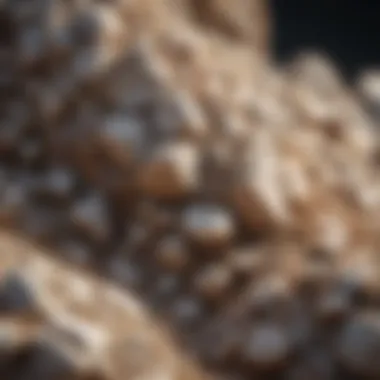
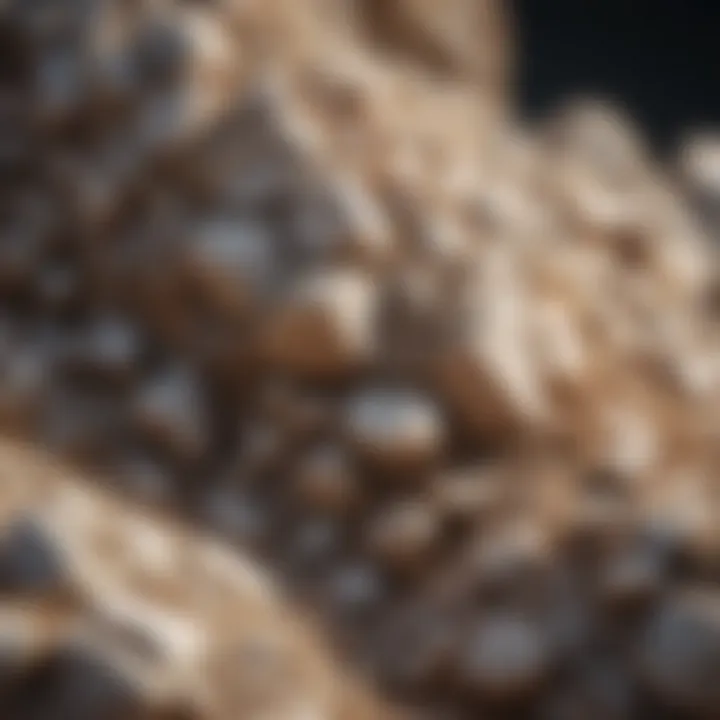
Featured Collectible of the Month
Overview
Feldspar is a mineral that captures interest due to its abundance and versatility in various fields. This mineral comprises a significant part of the Earth’s crust, making it vital not only in geology but also in the ceramics and glass industries. Collectors often seek feldspar specimens for their unique visual characteristics and historical context. Whether you are a seasoned collector or a novice, understanding feldspar can enhance your appreciation of geological specimens.
Historical Significance
The study of feldspar dates back centuries. Early geologists categorized feldspar, recognizing its different types and the role it plays in rock formation. Major contributions in feldspar research have been made throughout history, significantly shaping our understanding of geology and mineralogy. This mineral was a fundamental subject in the works of renowned scientists, reflecting its importance in not just academic circles but also in practical applications across various industries.
Identification Techniques
Visual Characteristics
Identifying feldspar involves observing its key visual traits. Feldspar typically appears in a range of colors, including pink, white, grey, and green. It often exhibits a glassy luster and may display a two-directional cleavage pattern. Under natural light, some feldspar varieties reveal a pearly or opalescent quality. These characteristics can assist collectors in distinguishing feldspar from other minerals.
Resources for Identification
To effectively identify feldspar, various resources can be utilized:
- Books on mineral identification: Titles like "Minerals of the World" provide detailed descriptions.
- Online forums: Websites such as reddit.com have communities of mineral enthusiasts who can offer guidance and insight.
- Museums and Geological Institutions: Visiting local museums can provide hands-on experience and expertise on feldspar and other minerals.
"Understanding feldspar's characteristics and varieties is essential for any serious mineral collector."
This comprehensive approach aids collectors in understanding feldspar as not just a mineral but a piece of Earth's history.
Prelims to Feldspar
Feldspar is a mineral of paramount significance in various fields, including geology and industry. Its relevance extends to the day-to-day functions of many sectors, providing essential materials for manufacturing and construction. In this article, we aim to unpack the intricate nature of feldspar, its composition, types, and the role it plays in the formation of rocks. By understanding feldspar, readers can appreciate not only its geological importance but also its applications in ceramics and other materials.
Definition and Overview
Feldspar refers to a group of rock-forming minerals that constitute about 60% of the Earth's crust. These minerals are primarily composed of aluminum silicates combined with varying proportions of sodium, potassium, and calcium. The most common types of feldspar include orthoclase, plagioclase, and microcline. Their chemical composition contributes significantly to their physical properties, making them highly versatile in both natural and industrial contexts.
A clearer grasp of feldspar includes its appearance, which generally ranges from colorless to white, though some varieties may show shades of pink, gray, or green depending on the impurities present. Understanding its structure and characteristics provides a solid foundation for delving deeper into its geological significance.
Significance of Feldspar in Geology
In the realm of geology, feldspar plays an indispensable role. It is not only a primary component of many igneous rocks but also contributes to the metamorphic and sedimentary rock cycles. The mineral's presence signifies particular environmental conditions during rock formation, offering geologists valuable insights into Earth's history.
Feldspar aids in deciphering mineral assemblages within rock samples. By examining the types and quantities of feldspar in a rock, geologists can infer the conditions under which the rock was formed, including temperature, pressure, and the chemical environment. Additionally, feldspar is crucial in the formation of clay minerals, which further influences soil quality and fertility.
"Feldspar is a key mineral for understanding not only geological formations but also for interpreting the Earth's past."
The study of feldspar is essential for geological mapping and exploration of natural resources. For collectors and enthusiasts, recognizing the importance of feldspar enhances one's appreciation of geological samples and the processes that shape our planet.
Chemical Composition of Feldspar
Understanding the chemical composition of feldspar is crucial in appreciating its role in both nature and various industries. Feldspar is a complex aluminosilicate mineral that consists mainly of framework silicate crystals. This composition defines its physical properties, stability, and uses, making it a pivotal component in geology and manufacturing.
Main Elements in Feldspar
Feldspar primarily contains the following elements:
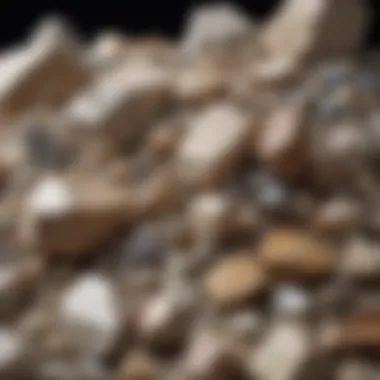
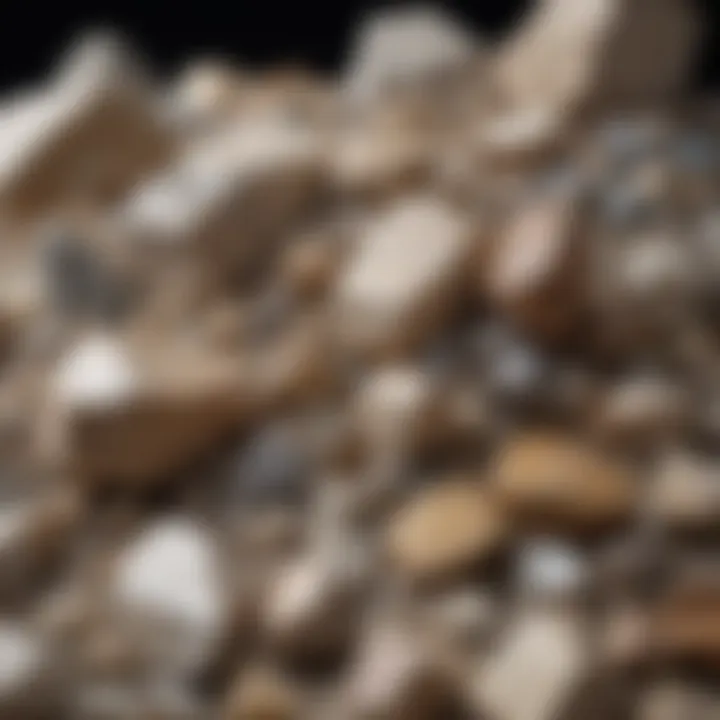
- Silicon (Si): The backbone of feldspar's structure, silicon forms the tetrahedral network that gives feldspar its strength.
- Aluminum (Al): Typically found in conjunction with silicon, aluminum enhances the mineral's stability and aids in its formation process.
- Sodium (Na) and Potassium (K): These alkali metals play a significant role in the composition of orthoclase feldspar, while plagioclase feldspar incorporates both sodium and calcium.
- Calcium (Ca): Present mainly in plagioclase feldspar, it contributes to the mineral's unique properties and appearance.
The specific ratio of these elements determines the feldspar type, critical for various applications, including ceramics and construction materials. Each element contributes distinct properties, with varying levels of hardness, melting point, and chemical reactivity influencing the mineral's applications.
Crystal Structure and Formation
Feldspar's crystal structure is a defining feature of this mineral. It typically exhibits a framework structure known as a three-dimensional silicate framework. This particular arrangement enhances the mineral's durability.
The formation of feldspar can occur through various geological processes, including:
- Magma Cooling: Feldspar crystallizes from molten rock as it cools, forming larger crystals in igneous rocks.
- Metamorphic Activity: During metamorphism, existing minerals can undergo transformations, creating feldspar from other minerals under intense heat and pressure.
- Weathering Processes: Feldspar can also form through weathering and alteration of other feldspar or plagioclase minerals, refining it into a more stable form.
"Feldspar is essential not only in geological terms but also in technological applications, influencing various industries from ceramics to electronics."
Understanding these formation processes helps geologists and collectors identify different feldspar types in the field. It also informs collectors about potential locations and techniques for sourcing high-quality specimens.
Types of Feldspar
Understanding the types of feldspar is essential for a variety of purposes, especially for collectors and professionals in geology and related fields. Feldspar is not a single mineral; rather, it encompasses a range of minerals that share a similar structural framework yet exhibit distinct chemical compositions and properties. The significant types include orthoclase, plagioclase, and microcline. Each type has unique characteristics that affect its occurrence in nature, its uses, and how it is appreciated in collection.
Orthoclase Feldspar
Orthoclase feldspar is classified under the group of potassium feldspars. Its chemical formula is KAlSi3O8 and it typically appears as a colorless to pink or reddish mineral. Orthoclase is prevalent in various igneous and metamorphic rocks.
Its importance lies in several factors:
- Physical Properties: Orthoclase exhibits two distinct cleavage planes. This property helps in identifying it among other minerals.
- Usage in Ceramics: It is widely used in the ceramics industry due to its ability to withstand high temperatures and create durable products.
- Collectibility: For rock and mineral collectors, orthoclase can present valuable specimens, especially when found in well-formed crystals.
Collectors often find Gemmy orthoclase specimens highly desirable. The clarity and depth of color can significantly increase their value in the market.
Plagioclase Feldspar
Plagioclase feldspar, on the other hand, forms a solid solution series ranging from sodium-rich albite to calcium-rich anorthite. Its general formula is (Na,Ca)(Si,Al)4O8. This type of feldspar is commonly found in igneous rocks such as basalts and granites.
Several elements highlight the importance of plagioclase:
- Variety: Because of the range in its composition, plagioclase exhibits different physical properties and colors. Each variation has relevance in mineralogical studies and practical applications.
- Significance in Geology: It plays a crucial role in the classification of volcanic rocks and is key in understanding the processes involved in the formation of the Earth's crust.
- Attractive Forms for Collectors: Some plagioclase types, like labradorite, display iridescent properties, making them sought after for collection.
Microcline Research
Microcline, another form of potassium feldspar, shares a similar chemical composition to orthoclase, but it has a different crystal structure. Microcline can display a variety of colors including green, pink, and white, which makes it a favorite among gemstone enthusiasts.
Research surrounding microcline has expanded significantly:
- Gem Quality: Some varieties, such as amazonite, are used in jewelry, presenting a lucrative market for collectors.
- Insights Into Crystallography: Studies on microcline contribute valuable insights into the methods by which minerals crystallize and undergo alteration. Such research can enhance understanding of geological processes.
- Use in Industry: Microcline is also relevant in glass and ceramics manufacturing, much like orthoclase.
Formation of Feldspar
Understanding the formation of feldspar is crucial in appreciating its role within the Earth's crust. Feldspar forms through both geological processes and specific environmental conditions that dictate its presence in various rock types. This section delineates several key elements regarding feldspar formation, focusing not only on the geological conditions but also its implications in rock identification and the study of geological history.
Geological Processes Involved
Feldspar primarily forms under high temperature and pressure conditions in igneous environments. During the crystallization of molten rock, or magma, feldspar begins to crystallize as it cools. The process is influenced by the cooling rate of the molten rock. Slow cooling allows for the formation of larger crystals, while rapid cooling results in smaller, more numerous crystals. Key factors include:
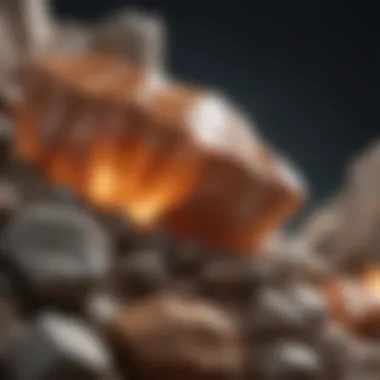

- Temperature: Typically between 700 °C to 1,200 °C.
- Pressure: Varies according to the depth at which the magma resides.
- Chemical Composition: Different elements present in the magma determine the type of feldspar that crystallizes. For instance, the presence of sodium and calcium can lead to the formation of plagioclase feldspar, whereas potassium can lead to orthoclase feldspar.
Occurrence in Igneous Rocks
Feldspar is among the most common minerals found in igneous rocks. It can occur as:
- Plagioclase Feldspar: Generally found in basalt and diorite, it demonstrates a solid solution series varying from sodium and calcium compositions.
- Orthoclase Feldspar: Often found in granite and rhyolite, characterized by its potassium content.
The distribution of feldspar within these rocks is not uniform. Instead, it can reflect the cooling history of the magma from which the rock is derived. For example, granitic rocks may have a higher percentage of orthoclase due to their slower cooling rates.
Role in Metamorphic and Sedimentary Rocks
Though primarily associated with igneous rocks, feldspar also plays a significant role in metamorphic and sedimentary contexts. In metamorphic rocks, feldspar may recrystallize under heat and pressure, potentially altering its form and composition. In sedimentary rocks, feldspar is often found within sandstone, serving as a significant fragment in rock composition.
The presence of feldspar in these rock types aids geologists in understanding past geological conditions. For rock collectors, identifying feldspar in various rock formations can provide insights into the formation and alteration processes the rock has undergone over time.
Feldspar not only contributes to the physical composition of rocks but also serves as an indicator of the geological environment in which the rock was formed.
In summary, feldspar's formation is integral to its presence in a variety of rock types, influencing both their physical properties and geological histories. The understanding of these processes enriches the overall study of geology.
Applications of Feldspar
Feldspar's practical applications span numerous sectors, underscoring its significance in both industrial and artistic fields. Understanding where and how feldspar is utilized provides invaluable insights into its role beyond geology. This section elaborates on its major applications, thereby highlighting its contribution to several industries.
Use in Ceramics and Glass
Feldspar is a crucial component in the ceramics and glass industries, playing an indispensable role in the production of items ranging from everyday tableware to intricate art pieces. In ceramics, feldspar acts as a flux, which lowers the melting temperature of raw materials. This property is essential for the formation of clinker and helps achieve the desired vitrification.
In glass manufacturing, feldspar contributes to the production of high-quality glass by enhancing durability and thermal resistance. Certain types, like soda feldspar, are preferred for glass production due to their low melting points, which save energy and increase the efficiency of the melting process. The end products, from bottles to light fixtures, benefit from the properties imparted by feldspar, such as clarity and strength. The utilization of feldspar supports sustainability in these industries by reducing energy consumption.
Role in Industrial Minerals
Feldspar also serves diverse functions as an industrial mineral. Its properties make it a valuable addition to numerous applications, such as in paints, plastics, and rubber industries. By acting as a filler or extender, feldspar provides bulk and improves the performance of these materials. For instance, in paints, it aids in achieving desired viscosities and enhances the finish of the final product.
Moreover, feldspar's inert chemical nature ensures that it does not react with other materials, making it a reliable additive across various processing stages. Despite the different formulating requirements in each industry, feldspar maintains its core functionality, showcasing versatility that many materials do not possess. This adaptability solidifies feldspar's position as a sought-after resource in the industrial minerals market.
Feldspar in the Manufacturing Industry
In the broader scope of manufacturing, feldspar finds its place in the production of cement and concrete. Its role can be critical in achieving the required strength and durability in these construction materials. By combining feldspar with other components, manufacturers can obtain specific properties in their mixes that align with technical performance standards.
Additionally, manufacturers use feldspar in the production of various household goods. Its advantageous characteristics contribute to producing non-stick cookware and other kitchenware, where durability and resistance to thermal shock are paramount.
Overall, feldspar's multifaceted applications demonstrate its essential role in supporting various industries, catering to both operational efficacy and product quality. Its continued relevance, especially in modern industrial processes, highlights the ongoing importance of this mineral in everyday life.
Feldspar is not just a mineral; it is an essential part of many materials we use daily, from pottery to construction.
Feldspar's widespread applicability reminds us of its importance in our material culture and industry. By acknowledging its diverse applications, we gain a greater appreciation for feldspar's contribution to our world.
Feldspar in Collectibles and Hobbyist Interest
Feldspar holds a significant place in the world of mineral collecting and hobbyist interests. This mineral is not only interesting because of its wide occurrence in nature but also due to its varied forms, colors, and structures. Collectors appreciate feldspar for its beauty and the stories it tells about the geological processes that shaped our planet. Furthermore, feldspar's abundance makes it accessible, attracting a diverse range of enthusiasts from beginners to experienced collectors.
Identification and Collection Techniques
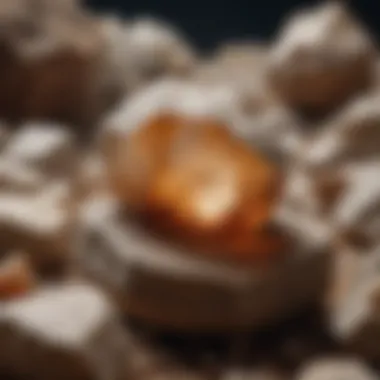
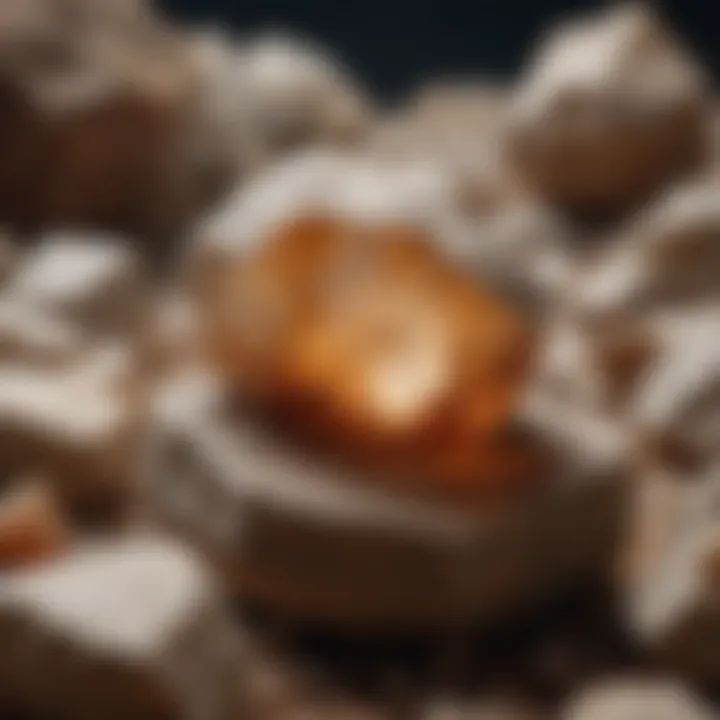
Identifying feldspar is crucial for any collector. The first step is understanding its physical properties. Feldspar crystals can vary greatly in appearance. The most common types include orthoclase and plagioclase. Orthoclase, often found in pink to white hues, displays a glassy luster. Plagioclase, on the other hand, comes in shades of gray and white, often with striations that can help in distinguishing it from other feldspar varieties.
To identify feldspar, collectors can use the following techniques:
- Crystal Form Examination: Feldspar typically forms in a prismatic shape with two perfect cleavage planes.
- Hardness Test: Use the Mohs hardness scale. Feldspar ranks about 6 to 6.5, meaning it can scratch glass but not quartz.
- Luster Analysis: Look for a vitreous or pearly luster, common in many feldspar varieties.
- Color and Transparency Assessment: Colors can range widely, and some varieties are transparent or translucent.
Collecting feldspar specimens often requires careful fieldwork. This could involve visiting quarries, riverbeds, and mountainous regions known for their igneous rocks. Collectors should use proper geological tools, such as hammers and chisels, to extract samples without damaging them. Documenting the location of each find can add value and context to the collection.
Preservation Methods
Proper preservation of feldspar specimens is essential to maintain their aesthetic and scientific value. Feldspar can be sensitive to environmental conditions, especially humidity and temperature.
Here are some effective preservation methods:
- Dry Storage: Store specimens in a dry, stable environment to avoid moisture damage. Ideally, use silica gel packets to absorb humidity.
- Avoid Direct Sunlight: Prolonged exposure to sunlight can fade colors and affect the mineral structure. Store in a dark or semi-dark area.
- Gentle Cleaning: If a specimen has dirt or debris, clean it gently with a soft brush. Avoid using harsh chemicals that can damage the surface.
- Display Options: For those wishing to show their collections, use display cases that offer UV protection and are made from durable materials.
Properly cared for feldspar specimens can be a source of joy and education for years to come.
Research and Scientific Studies on Feldspar
The systematic investigation of feldspar is fundamental for multiple disciplines, including geology, materials science, and environmental studies. Research in this field focuses on the mineral's properties, behavior under different conditions, and potential applications in various industries. Increased comprehension of feldspar helps scientists and manufacturers to utilize this mineral efficiently, promoting advancements in technology, construction, and more.
Recent Advancements in Feldspar Research
In recent years, significant progress has been made in feldspar research. One area of focus is the use of advanced analytical techniques to determine the mineral's structural and chemical properties. For instance, X-ray diffraction, scanning electron microscopy, and nuclear magnetic resonance spectroscopy have provided insights that were previously unattainable. These methods allow researchers to analyze the crystal structure of feldspar with greater precision, ultimately leading to a better understanding of how these minerals form in natural environments.
Another promising development involves the synthesis of synthetic feldspars. Scientists experiment with various synthesis techniques, producing feldspar-like materials that may exhibit engineered properties suited for specific applications. This research is crucial for fields such as ceramics, where tailored characteristics are often needed.
Moreover, interdisciplinary studies are emerging, combining geology with environmental science. Investigating how feldspar interacts with other minerals in the soil can inform us about nutrient cycling and soil stability, both essential for sustainable agriculture and ecosystem management. This research illustrates feldspar's wider importance beyond its traditional applications.
Future Directions in Feldspar Science
Looking ahead, future research on feldspar may take several exciting directions. There is a growing interest in exploring the environmental implications of feldspar mining and use. Sustainable practices will likely become a priority in studies, focusing on how mining affects local ecosystems and what measures can mitigate negative impacts. This direction aligns with the global push for more responsible resource extraction and usage.
Additionally, the potential for exploring feldspar's unique optical and thermal properties is significant. This includes investigating feldspar's use in new materials with functional applications, such as advanced ceramics and electronics. These applications may open new markets and uses for feldspar, making it a focal point of innovation in material science.
As we progress, the collaboration between industry and academic institutions will be increasingly vital. By sharing knowledge and resources, researchers can innovate faster and identify practical applications for their findings.
"The ability to understand and manipulate feldspar opens doors for both scientific discovery and industrial advancement."
Studying feldspar is essential not just for understanding the mineral itself but also for its broader impacts on geology, industry, and the environment. Further investigations will only enhance our appreciation of this key mineral.
End
The conclusion in this article serves as a crucial synthesis of feldspar's many facets. Throughout our exploration, we've uncovered feldspar's significance in various domains, notably in geology and industry. As an abundant mineral, feldspar's applications extend from ceramics to glass manufacturing. Understanding its composition not only enriches our knowledge of earth sciences but also connects to practical uses in daily life and industrial advancements.
Recap of Feldspar's Importance
Feldspar stands out for its geological importance as it forms a substantial part of the Earth's crust. It influences rock formation processes and contributes to the overall composition of igneous and metamorphic rocks. Additionally, the mineral's ability to enhance qualities in ceramics and glass marks it as a necessary component in industrial production. Thus, its role is not only fundamental in geosciences but also integral to various commercial endeavors.
- Abundance: Feldspar is one of the most common minerals found in nature.
- Geological Impact: It plays a vital role in the formation of igneous and metamorphic rocks.
- Industrial Applications: The mineral is extensively used in manufacturing glass and ceramics, affecting many products in daily life.
"Understanding feldspar is essential for both geologists and industry professionals as it bridges the gap between earth sciences and practical applications."
Encouragement for Further Exploration
The ongoing research and discoveries related to feldspar emphasize its dynamic nature within science and industry. Future studies may reveal more about the mineral's capabilities and potential uses. Given the importance of feldspar, collectors and hobbyists should consider exploring its diverse types and properties further. Engaging with local geological societies or museums can provide insights and materials for those keen on deepening their understanding.
- Join local geology clubs or forums to share information.
- Attend workshops that focus on mineral collection and identification.
- Explore educational resources such as online classes or field trips dedicated to mineralogy.
In closing, feldspar remains a mineral worthy of attention. Its applications and significance in enhancing various materials and processes compel us to keep learning. As both a collector and enthusiast, delving deeper into feldspar can provide joy and a richer appreciation for the Earth's geological treasures.



